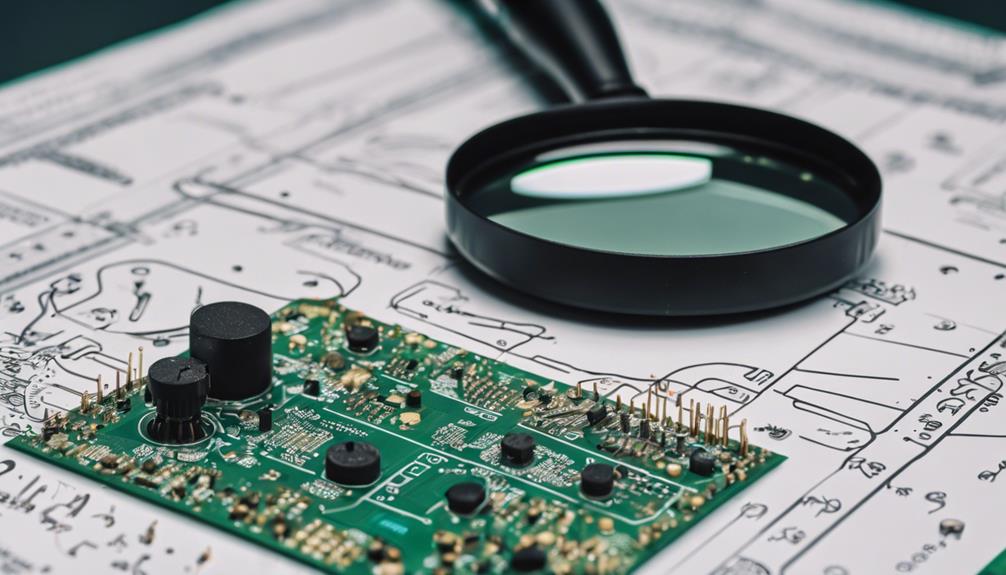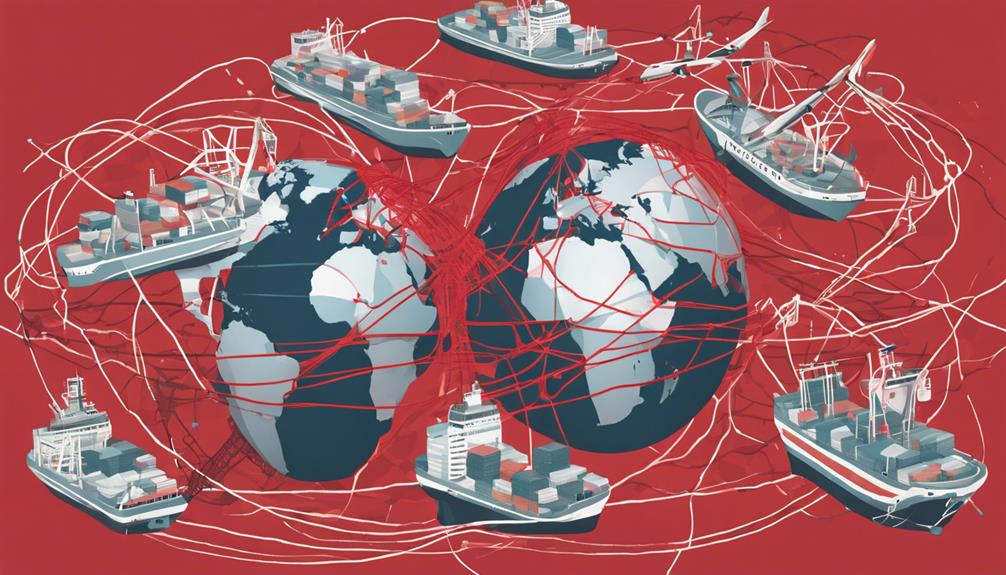When sourcing components, it's essential to take into account multiple factors to guarantee authenticity, quality, and reliability. Counterfeit components pose significant risks to product reliability and safety, and financial losses. Evaluate suppliers based on quality and standards, such as RoHS and ISO certifications. Compare prices and costs, including lead times, logistics, and additional fees. Assess technical support and reliability, including response times and failure rates. Finally, mitigate risks associated with end-of-life products and supply chain disruptions. By carefully taking into account these factors, you can make informed procurement decisions; exploring each of these considerations in depth will reveal further complexities and opportunities for optimization.
Key Takeaways
- Ensure component authenticity by sourcing from trusted suppliers and implementing strict quality control measures to prevent counterfeits.
- Evaluate quality and standards by checking for industry certifications like RoHS, REACH, and ISO to ensure reliability and safety.
- Compare unit prices and total costs, including logistics and additional fees, to optimize procurement processes and budget allocation.
- Assess lead times and availability to plan production schedules and avoid delays, and stay informed about market changes.
- Consider technical support and reliability, including response time and failure rate analysis, to minimize downtime and ensure customer satisfaction.
Ensuring Component Authenticity

The proliferation of counterfeit components in the global supply chain poses a significant threat to product reliability, safety, and performance, underscoring the critical necessity for ensuring component authenticity.
The financial implications are staggering, with the global semiconductor industry estimating losses of $169 billion annually. Counterfeit components can compromise product performance, safety, and reliability, leading to costly recalls and damage to brand reputation.
To mitigate these risks, it is vital to implement strict quality control measures and source components from trusted suppliers like Briocean Technology, which provides authentic components with traceable origins and quality certifications. Sourcing from authorized distributors is also essential in guaranteeing component authenticity.
Additionally, authenticity verification methods, such as checking manufacturer logos, serial numbers, holographic labels, and packaging, can help detect counterfeit components.
Evaluating Quality and Standards

Ensuring component authenticity is only half the battle, as even genuine components can fail to meet performance and safety expectations if they do not adhere to stringent quality and standards.
To mitigate this risk, it is important to evaluate the quality and standards of sourced components. Reputable manufacturers adhere to industry standards such as RoHS, REACH, and ISO certifications, ensuring that components meet rigorous testing procedures and specifications. These standards guarantee that components are reliable, efficient, and safe for use.
Quality Control measures, including testing and inspection, are essential to detecting defects and ensuring that components meet required specifications. Detailed documentation, including certifications and test reports, provides transparency and accountability.
Comparing Pricing and Cost

When sourcing components, a thorough comparison of pricing and cost is essential to make informed decisions. This involves a detailed evaluation of unit prices, as well as a holistic analysis of total costs, including shipping, taxes, and other expenses.
Unit Price Comparison
Component procurement teams rely on unit price comparison to evaluate the cost-effectiveness of different components, considering both financial and qualitative factors. This involves analyzing the cost per unit of each component to determine the best value for money. By comparing pricing and cost, businesses can identify the most cost-effective option that meets their quality and specification requirements.
Unit price comparison helps procurement teams make informed decisions by revealing the true cost of each component. This is achieved by breaking down the unit price to reveal hidden costs and potential savings opportunities. Effective unit price comparison allows businesses to optimize their procurement processes and maximize their budget allocation for components.
Total Cost Analysis
By examining the total cost of ownership, including acquisition costs, logistics expenses, and additional fees, businesses can make informed sourcing decisions that minimize expenditure and maximize profitability.
Total cost analysis is an important step in the component sourcing process, as it considers all expenses associated with acquiring components, beyond just the purchase price. This includes shipping costs, taxes, and potential tariffs, which can greatly impact the overall cost of ownership.
By comparing landed costs, businesses can choose the most cost-effective sourcing option for their specific needs. Total cost analysis promotes transparency in procurement processes and helps in budgeting accurately. It is essential for businesses to factor in all expenses related to component sourcing to optimize cost-efficiency and profitability.
Assessing Lead Times and Availability

When sourcing components, it is imperative to take into account the lead times for electronic components, which can range from weeks to a year, with most parts having a 12-20 week lead time from the manufacturer.
Factors such as global manufacturing changes, market demand, and unexpected disruptions in the supply chain can impact lead times, leading to delayed part orders that can impact production schedules and costs.
Incorporating lead times into production forecasts is crucial to avoid last-minute rushes and additional expenses. Staying informed about market changes and potential disruptions can help in planning for longer lead times and component availability.
Technical Support and Reliability

When evaluating technical support, two critical aspects to ponder are response time and failure rate analysis. A supplier's response time can greatly impact the resolution of issues, with faster response times minimizing downtime and production delays.
Response Time Matters
One critical aspect of a component supplier's technical support is its response time, as it can greatly impact the efficiency and productivity of the manufacturing process. A supplier's responsiveness to inquiries and issues reflects their commitment to customer service and satisfaction.
Delayed responses can lead to missed deadlines, increased costs, and potential customer dissatisfaction. Efficient technical support, on the other hand, can prevent production delays by quickly troubleshooting issues and providing guidance. This, in turn, minimizes downtime and increases overall productivity in manufacturing processes.
A supplier's response time is a critical factor in maintaining a positive relationship between the supplier and the manufacturer. By prioritizing response time, suppliers demonstrate their dedication to supporting their customers' success.
When evaluating component suppliers, manufacturers should consider the supplier's responsiveness as a key factor in their decision-making process. By doing so, they can ensure smooth operations, minimize production delays, and uphold a high level of customer satisfaction.
Failure Rate Analysis
In addition to vital response times, a component supplier's technical support plays a pivotal role in minimizing failure rates, guaranteeing that components operate reliably and efficiently throughout their lifespan. Failure rate analysis is an essential aspect of technical support, enabling component suppliers to identify areas for improvement and implement corrective actions.
By analyzing failure rates, suppliers can pinpoint weaknesses in their products and make informed improvement decisions. This, in turn, contributes to low defect rates, high product quality, and enhanced customer satisfaction. Reliable suppliers with low defect rates are better equipped to provide high-quality components that meet customer expectations.
Moreover, components with higher reliability ratings tend to have lower failure rates during operation, reducing the likelihood of disruptions in production processes. Effective technical support, combined with failure rate analysis, enables component suppliers to quickly resolve issues, minimizing downtime and ensuring seamless production.
Managing Global Supply Chain Risks

Frequently, global supply chains are confronted with a multitude of risks that can severely disrupt operations, including natural disasters, political instability, trade disputes, and pandemics. These risks can have devastating consequences, leading to supply chain disruptions that can impact business operations and profitability.
To mitigate these risks, it is essential to implement robust risk mitigation strategies.
Here are four key considerations for managing global supply chain risks:
- Diversify suppliers: Spread risk by working with multiple suppliers to minimize dependence on a single source.
- Conduct regular risk assessments: Identify potential risks and develop contingency plans to mitigate them.
- Implement supply chain visibility: Increase transparency across the supply chain to quickly respond to disruptions.
- Develop relationships with potential suppliers: Foster relationships with alternative suppliers to guarantee business continuity in the event of a disruption.
Mitigating End-of-Life Product Risks

When manufacturers discontinue components, the resulting end-of-life products can pose significant risks to supply chains, including increased costs, quality issues, and production delays. To mitigate these risks, it is essential to proactively manage component obsolescence.
This can be achieved by monitoring product lifecycle information from manufacturers, allowing for timely planning and identification of suitable alternative components. Effective supplier relationships are also vital in mitigating end-of-life risks. By fostering strong relationships, suppliers can provide early warnings of component discontinuation, enabling proactive planning and minimizing production disruptions.
Continuous market monitoring can also help identify potential end-of-life risks, enabling prompt action to be taken. By taking a proactive approach to managing end-of-life risks, organizations can minimize the impact of component obsolescence on their supply chains, reducing the likelihood of production disruptions and ensuring business continuity.
Frequently Asked Questions
What Are Sourcing Components?
While some may assume that sourcing components is simply a matter of procurement, it is, in fact, a multifaceted process that requires careful consideration of various factors.
To clarify, sourcing components involves identifying, evaluating, and procuring specific parts, materials, or products necessary for manufacturing or production. This process encompasses a broad range of components, from electronic parts to mechanical components, and is critical to maintaining production schedules, quality standards, and cost efficiency.
What Is the Sourcing Process in the Supply Chain?
The sourcing process in the supply chain is a multifaceted undertaking that encompasses identifying, evaluating, and selecting suppliers to procure goods and services. It involves a series of deliberate steps, including supplier identification, request for quotation, supplier evaluation, negotiation, and contract finalization.
This structured approach enables organizations to secure high-quality components at competitive prices, while ensuring timely delivery and reliability. Effective sourcing processes are vital for optimizing supply chain performance and achieving strategic business objectives.
What Is Sourcing Information?
As the thread that weaves together the intricate tapestry of production, sourcing information is the crucial process of identifying, locating, and procuring components essential for manufacturing.
It's the linchpin that guarantees seamless production and superior product quality. By gathering and analyzing data on suppliers, prices, and availability, sourcing information mitigates risks, optimizes costs, and fuels business growth.
What Is Sourcing Management?
Sourcing management refers to the strategic process of identifying, evaluating, and selecting suppliers for components. It encompasses activities such as supplier identification, negotiation, contract management, and performance evaluation.
Effective sourcing management optimizes production processes, guarantees product quality, and enhances supply chain resilience. By evaluating supplier capabilities, managing risks, and ensuring timely delivery, sourcing management enables organizations to achieve cost savings, quality improvements, and increased competitiveness.


